Correct selection method and device configuration of LED driving power supply
Due to LED energy savings, long life, durability and flexible design, LEDs are rapidly replacing incandescent and fluorescent lights in indoor and outdoor lighting . But choosing the right LED is only part of the design equation. To achieve total efficiency, durability and longevity in your solid-state lighting design, you need to choose the right power source to match your application requirements to the LEDs you use. This article will provide you with some useful suggestions for consideration when choosing a power supply.
Related background introduction
Once the power supply voltage of the LED is equal to or greater than the forward voltage drop of the diode (typically in the 2-3V region), the LED begins to produce light. The current required for full brightness varies from device to device, but is typically 350 mA for a 1 W LED (usually the smallest size in lighting applications). Unlike incandescent lamps, LEDs are non-linear devices. This means that once the supply voltage exceeds the forward voltage of the diode, the passing current increases exponentially with the supply voltage. Without some form of current regulation, LED chips will become expensive, monostable flash bulbs.
To prevent this, the power supply must provide the proper voltage at the right current. The easiest way is to select a power supply with an output voltage greater than the forward voltage of the selected LED and use a current limiting resistor to limit the current to the maximum specified by the LED manufacturer. A disadvantage of this approach is that one of the main advantages of LED illumination is that the high efficiency is affected by the power dissipated by the current limiting device.
Another problem with this approach is that the LED junction temperature affects the forward voltage. Since the output voltage of the power supply is fixed, this in turn means that if the voltage across the current limiting device changes, the current will also change. The varying current will affect the amount of light emitted and reduce the reliability of the LED. The best way is to drive the LED with a constant current source. In this way, the current can be set to the maximum specified by the LED manufacturer for maximum efficiency and reliability, or to achieve the precise brightness required, and to eliminate the effects of junction temperature when the LED or ambient temperature changes.
One benefit of using LEDs in lighting applications is the ease of changing brightness. This can be done by changing the current through the LED, but operating the LED less than its maximum current will reduce efficiency and may result in a slight change in color. Therefore, a better approach is to pulse the current between zero and maximum to change the average light emitted. As long as this is done at a high enough frequency to avoid the pulse being seen by the human eye as a flash, this is the best way to achieve dimming. The pulse of current is usually measured at a fixed frequency, and the ratio of zero to full current changes. This is the pulse width modulation (PWM) method.
Select power
The type of power source selected for the lighting application will be based on several factors. First, consider the environment in which the application runs. Is the application indoors or outdoors? Does the power supply need to be waterproof or require a special IP rating? Can the power supply use conduction cooling or use only convection cooling?
Next, define the overall power requirements. A single luminaire may only require a small power supply, but a complex system may require hundreds of watts of power. Also, do you need other features? For example, does the power supply need to operate in a simple constant voltage mode or constant current mode, and does the application require dimming?
Regulations and regulations are important
Well, now is the time to consider the regulations. Does the entire system need to operate within a certain harmonic current range? Does it need to meet the safety standards for lighting, or is ITE power sufficient? And in this age of energy sensitivity, how can power supply effectively meet local or regional standards?
Equally important, in some local government agencies, discounts or other subsidies are offered to products that meet specific efficiency and power factor correction levels. Are products sold in these locations? Again, it's important to know if your design criteria meet the requirements, including any requirements for power consumption when turning off the power.
safety standard
There are various standards for lighting systems. Internationally, Part 1 of IEC 61347 covers the general safety requirements for luminaire control devices, and Section 13 (2) of Part 2 applies to LED module power supplies. The United States has UL8750, and Europe has EN61347, which are all named in the IEC format.
Harmonic current
Lighting applications typically require harmonic current emissions to meet the requirements of EN61000-3-2, while the lighting category is Class C. In this category, there is a set of limits for active input power above 25W, and another set for 25W and below. However, this standard only mentions discharge lighting of 25 W and below.
To meet the 25W limit, power factor correction is usually required, and since the limit is calculated as a percentage of amperage rather than an absolute value, it is best to use a power supply specifically for lighting applications instead of an ITE type power supply. However, as long as the lighting load is above 40-50% of the full load rating, the ITE power supply may reach its limit.
As an example here, XP Power's IP67 DLE series is a power supply series designed for LED lighting applications. The range includes 15, 25, 35 and 60 watt models and meets EN61347 and UL8750 safety regulations.
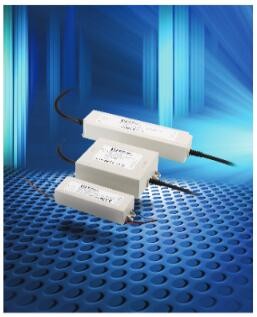
figure 1. An example LED power supply from the 15-60 watt DLE series from XP Power.
LED configuration
Some lighting applications may use only one LED. This power is typically about 1W, the forward voltage is in the range of 2-3V, and the forward current is about 350mA. While this produces a bright light source, it is more likely that the LED will be used in a single lighting fixture or some array of fixtures to produce a brighter and more uniform source. LEDs are typically used in one of four configurations. The LEDs are arranged in series, parallel or matrix (series and parallel combinations) to be driven from a single source. The fourth configuration uses multiple channels and requires multiple power supplies.
Tandem configuration
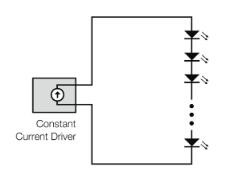
Figure 2 - LED series connection
In a series configuration, the individual LEDs are arranged in series. The advantage of this is that the same current passes through each of them, resulting in the same brightness of the emitted light. Another advantage is that if one LED fails during a short circuit, the other LEDs remain unaffected and remain lit. The disadvantage is that if an LED fails in an open circuit, the current will be interrupted and all other LEDs will be extinguished. Another disadvantage is that if many LEDs are needed to produce the required amount of light, the sum of the forward voltages may require a power supply that uses a relatively high output voltage.
Parallel configuration
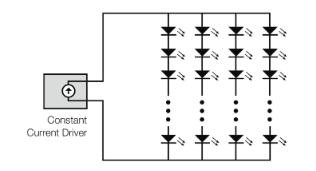
Figure 3 - LED Parallel Connection
When connected in parallel, the LEDs can still be arranged in series in two or more LED strings. The advantage is that for the same number of LEDs, ie the same brightness, the power supply can have a lower output voltage because the number of LEDs in each string can be reduced. Another advantage is that if one LED in one string becomes an open circuit, the other strings are unaffected and the luminaire can still illuminate but the brightness is reduced. The disadvantage is that because there is a slightly different forward voltage in each string, the current in each string cannot be precisely controlled by a single power supply, so each string may require a current balancing device, which reduces overall efficiency.
Matrix configuration
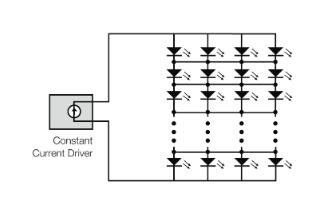
Figure 4 - LEDs connected in a matrix configuration
In a matrix configuration, the LEDs can be similarly configured in a parallel configuration, but each LED between the string and the string is connected. The biggest advantage of this configuration is that if a single LED becomes an open circuit, there is still a path for current to flow through all of the other LEDs in the string, so the light output is hardly reduced. The main disadvantage is that it is more difficult to control the current in each string because the current balancing device cannot be used. This means that the LEDs used must have a closely matched forward voltage, which can add cost.
Multi-channel configuration
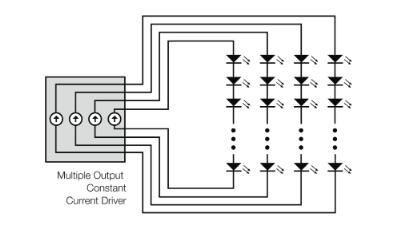
Figure 5 - LEDs connected by multi-channel
Using this approach, the LEDs are arranged in series in multiple strings, similar to a parallel and matrix configuration. The advantage is that the total string voltage can be reduced for any given brightness desired, and since each string is supplied by a single power supply, failure of any one string will not affect the other strings in any way. The downside is that the power supply will be more expensive because each string has a separate output but is more flexible in the application.
The utility model relates to a medical atomization treatment and humidifying device belonging to the technical field of medical equipment and household appliances.
Professional Medical Atomization manufacturer is located in China, including Medical Vape,Dose Control Vape Pen,Supersonic Wave Vape, etc.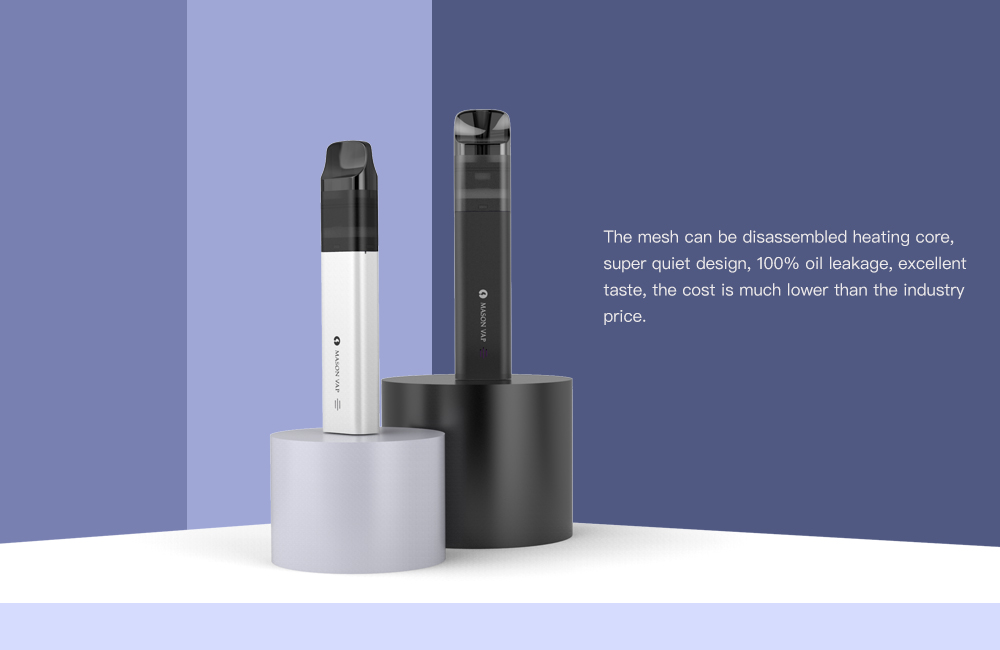
Medical Atomization,Medical Vape,Dose Control Vape Pen,Supersonic Wave Vape
Shenzhen MASON VAP Technology Co., Ltd. , https://www.cbdvapefactory.com